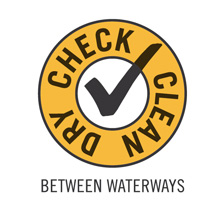| |
|
|
| |
| DIDYMO BIOSECURITY |
| |
 The following information has been provided by Dave Cade better known to most of us as Didymo Dave. I'd like to thank him for taking the time to send this to me and for his never-ending efforts to protect the freshwaters of New Zealand from aquatic weeds and other pests. The following information has been provided by Dave Cade better known to most of us as Didymo Dave. I'd like to thank him for taking the time to send this to me and for his never-ending efforts to protect the freshwaters of New Zealand from aquatic weeds and other pests.
With the discovery of Didymo in New Zealand Biosecurity New Zealand implemented the CHECK CLEAN DRY programme to halt the spread of this unwanted freshwater algae. Since then the education campaign has been widened to include all aquatic weeds and pest fish that pose a threat to the waterways in New Zealand, including the pristine Tongariro River that Mike guides on.
Below are some answers to frequently asked questions about Didymo and CHECK CLEAN DRY;
1) WHERE DID DIDYMO COME FROM?
Didymo has existed in parts of North America, Europe and Northern Asia as a native for centuries so it is not new on the world scene. Around 1990 a variant type of Didymo appeared on Vancouver Island and it is that variant that has made its way to New Zealand not the native Didymo. Alarmingly, there are now 2 different DNA variants in New Zealand.
2) IS DIDYMO IN THE NORTH ISLAND?
The waterways of the North Island are tested on a regular basis. To date there has been no Didymo found in the North Island but the water test results are retrospective. The day to day status of the North Island is unknown.
3) ARE BIRDS SPREADING DIDYMO?
There is no evidence that birds are spreading Didymo or any other aquatic weeds. The Nelson lakes area is a prime example. The Buller and Gowan rivers which are the outlets for Lakes Rotoroa and Rotoiti are heavily infected and were two of the early rivers to show up as positive in yet the Sabine and D'Urville rivers which feed into the lakes are negative. The Rotorua Lakes are another good example with weeds in some lakes and not in others.
4) ISN'T TAUPO ONE CATCHMENT?
This is a question that I get asked a lot and the answer is no. The Lake is a common catchment not the rivers. For example if an angler was to fish any other river and then move to the Tongariro River they are moving from one catchment to another and therefore need to CHECK CLEAN DRY. If they were to fish anywhere in the Lake and then transfer to the Delta then they are in the one catchment and can move around freely.
5) WHY CLEAN IF DIDYMO HASN'T BEEN FOUND IN THE NORTH ISLAND?
As stated in point 2 the day to day status of the North Island is unknown and therefore all Rivers and Lakes should be treated as positive. In addition there are other aquatic weeds such as Hornwort which is present in Lakes Rotoaira and Taupo but not present in Lakes Otamangakau or Kuratau. Also, anyone familiar with the Waikato River system will appreciate the problems Lagarosiphon is causing and Alligator weed is on the march in the Waikato River. There is therefore, sufficient reasons to CHECK CLEAN DRY whether Didymo is here or not.
6) WILL CHECK CLEAN DRY STOP THE TRANSFER OF PEST FISH?
Yes we believe it will. Pest fish are widely spread throughout the Waikato River system in particular and the transfer of one of these species into Lake Taupo could have dramatic implications for the health of the fishery. By adhering to the CHECK CLEAN DRY programme no pest fish eggs should survive to be transferred.
For any further information contact: Didymo Dave 027 2409603 |
|
|
|
|
|
| |
| Back to Top |
| |
|
|
|